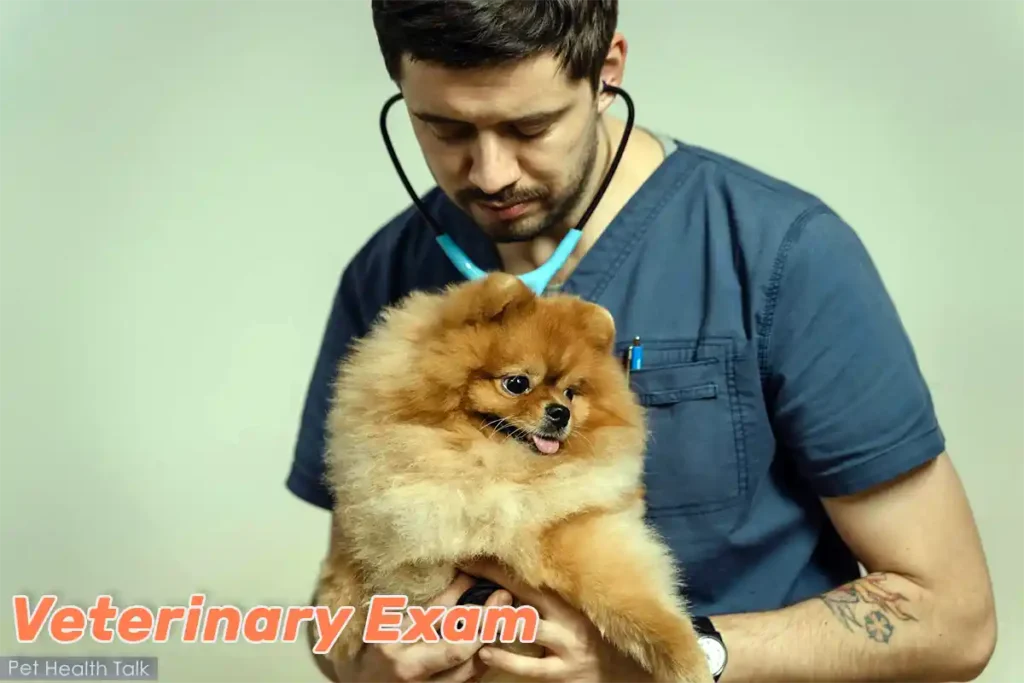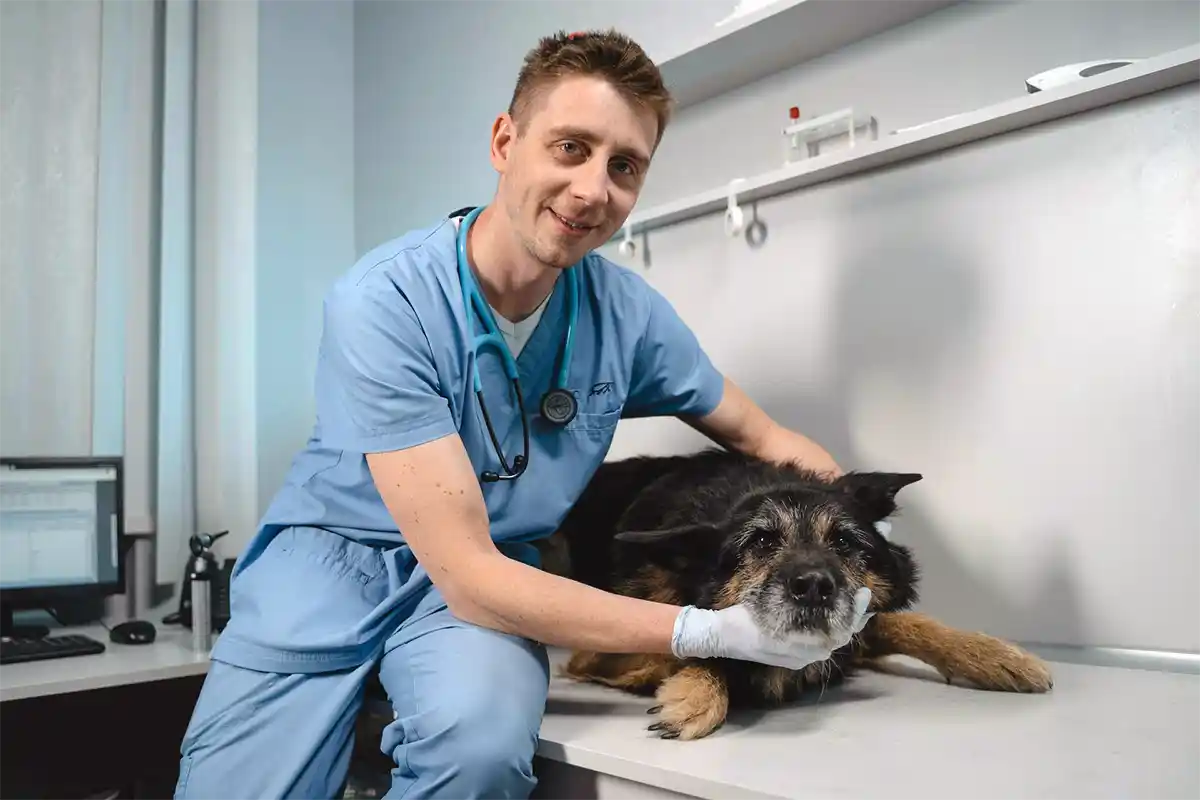When to visit the Vet
Your dog’s wagging tail and loving eyes may not reveal much when it comes to their health, but their actions often do. Subtle changes in behavior, eating habits, or energy levels could be early signs of a serious health issue. Recognizing these warning signs can mean the difference between a manageable condition and an emergency.
As pet owners, it’s easy to dismiss small changes as quirks,” says Dr. Esther Knoetze, BSc, BVSc. “But dogs are experts at hiding their discomfort, which is why proactive observation is crucial.”
In this guide, you’ll learn the top 11 warning signs that your dog needs a veterinarian’s attention—plus actionable steps to protect their well-being.
Why Recognizing Dog Health Warning Signs Early is Crucial
Dogs have a natural instinct to hide pain or discomfort, often delaying visible symptoms until their condition worsens. This behavior, while protective in the wild, can pose a challenge for pet owners. According to Dr. Esther Knoetze, “Early detection can save not only your dog’s life but also reduce the cost and complexity of treatment.”
Key Insight: Studies show that over 70% of chronic illnesses in dogs, including kidney disease and diabetes, respond better to treatment when caught early (American Veterinary Medical Association, 2023).
1. Loss of Appetite or Changes in Eating Habits
Dogs skipping a meal here and there might not raise immediate concern, but persistent appetite changes often signal underlying health issues. A dog refusing food for over 24 hours may indicate problems like dental pain, gastrointestinal blockages, or more severe conditions such as liver disease. Conversely, an increased appetite might point to hormonal imbalances, like hypothyroidism or diabetes.
“As a veterinarian, I always encourage pet owners to track subtle changes in eating behavior,” advises Dr. Esther Knoetze. “A refusal to eat, especially when combined with lethargy or vomiting, should prompt immediate veterinary evaluation.”
Signs to Watch For:
- Refusal to eat for over 24 hours.
- Persistent begging despite being fed normally.
- Associated symptoms like vomiting, diarrhea, or lethargy.
Why It Matters:
- According to the World Small Animal Veterinary Association, consistent changes in eating patterns are among the first indicators of chronic illness in pets.
When to Act:
- If your dog’s appetite doesn’t normalize within a day, contact your veterinarian promptly.
2. Excessive Thirst or Urination
Does your dog seem thirstier than usual or need more bathroom breaks than normal? While occasional changes in drinking habits may seem harmless, consistent or excessive thirst and urination (known as polydipsia and polyuria) can signal serious health problems.
These symptoms are often the body’s way of signaling that something isn’t working as it should,” explains Dr. Esther Knoetze, BSc, BVSc. “In my practice, I’ve seen that catching these signs early can significantly improve outcomes for conditions like diabetes or kidney disease.”
Signs to Watch For
- Drinking more water than usual over several days.
- Urinating more frequently, including accidents indoors.
- Accompanying symptoms like lethargy, weight loss, or vomiting.
Common Causes
- Diabetes Mellitus: High blood sugar causes increased thirst as the body attempts to flush out excess glucose.
- Key Fact: Around 1 in 500 dogs develop diabetes, with excessive thirst often being the first noticeable symptom (American Veterinary Medical Association, 2023).
- Kidney Disease: Impaired kidney function disrupts fluid regulation, leading to frequent urination and increased thirst.
- Important Insight: According to the International Renal Interest Society, early-stage kidney disease is manageable with timely intervention.
- Cushing’s Disease: An overproduction of cortisol can lead to excessive drinking and urination, often accompanied by a pot-bellied appearance or thinning fur.
When to Act
- Track your dog’s water intake and urination for 24–48 hours.
- Consult your vet if these symptoms persist or worsen. Bringing a fresh urine sample can expedite diagnostic tests for conditions like urinary tract infections or diabetes.
3. Unexplained Weight Loss
Have you noticed your dog losing weight without explanation? While small fluctuations in weight are normal, a significant or rapid loss may indicate an underlying health issue requiring immediate attention.
Unexplained weight loss is a critical sign that something may be wrong with your dog’s health,” says Dr. Esther Knoetze, BSc, BVSc. “Conditions like diabetes, parasites, or even early-stage cancer often present as weight loss before more obvious symptoms develop.”
Signs to Watch For
- Noticeable weight loss over a short period, even with normal eating habits.
- Visible ribs or spine, despite your dog maintaining their appetite.
- Additional symptoms like vomiting, diarrhea, or lethargy.
Common Causes
- Parasites: Intestinal worms, such as hookworms or tapeworms, can deprive your dog of essential nutrients.
- Key Insight: According to the Companion Animal Parasite Council, untreated intestinal parasites are a leading cause of malnutrition in dogs.
- Diabetes Mellitus: Despite an increased appetite, dogs with diabetes often lose weight as their body breaks down fat and muscle for energy.
- Did You Know? Diabetes affects approximately 1 in 500 dogs, with weight loss being one of the first signs (American Veterinary Association, 2023).
- Cancer: Some cancers, like gastrointestinal tumors, disrupt the body’s nutrient absorption, leading to rapid weight loss.
- Thyroid Imbalances: While rare, hyperthyroidism can cause increased metabolism, resulting in weight loss.
- Kidney or Liver Disease: Both conditions impair nutrient absorption, often causing gradual weight loss.
When to Act
- Monitor your dog’s weight weekly using a pet scale or by feeling for their ribs and spine.
- Consult your veterinarian if your dog loses more than 10% of their body weight without an obvious reason.
- Document any accompanying symptoms, like decreased energy or vomiting, to share with your vet.
Regular weight monitoring, particularly for senior dogs, can be a lifesaver,” advises Dr. Esther Knoetze. “Even subtle changes can indicate the onset of serious conditions.”
4. Persistent Vomiting or Diarrhea
Vomiting or diarrhea can be common in dogs, often resolving within 24 hours. But when these symptoms persist or become severe, they may indicate serious health issues that require veterinary attention. Persistent gastrointestinal problems can quickly lead to dehydration, electrolyte imbalances, or even life-threatening conditions.
In my practice, I’ve seen cases where early intervention saved dogs from dangerous complications,” explains Dr. Esther Knoetze, BSc, BVSc. “Prolonged vomiting or diarrhea, especially with additional symptoms like blood or lethargy, should never be ignored.”
Signs to Watch For
- Vomiting or diarrhea lasting more than 24 hours.
- Blood in vomit or stools (bright red or dark, tar-like).
- Signs of dehydration: dry gums, sunken eyes, or skin that doesn’t bounce back when pinched.
- Lethargy, fever, or refusal to eat or drink.
Common Causes
- Dietary Indiscretion: Eating spoiled food, non-food items, or table scraps often causes stomach upset.
- Did You Know? “Garbage gut,” caused by eating inappropriate items, is one of the most frequent reasons for emergency vet visits.
- Parasites: Giardia, coccidia, and roundworms can lead to chronic diarrhea, often accompanied by mucus or blood.
- Toxins or Foreign Bodies: Ingesting household toxins or objects like toys can result in severe vomiting.
- Important Fact: Nearly 15% of emergency vet visits involve gastrointestinal obstruction or toxin ingestion (Veterinary Emergency and Critical Care Society, 2023).
- Viral or Bacterial Infections: Parvovirus and salmonella are serious conditions that cause severe vomiting and diarrhea, especially in puppies.
- Chronic Conditions: Pancreatitis, inflammatory bowel disease (IBD), or food allergies can lead to recurring gastrointestinal symptoms.
When to Act
- Consult your veterinarian if vomiting or diarrhea persists beyond 24–48 hours, or if you notice blood in your dog’s stool.
- Seek emergency care immediately if your dog exhibits signs of dehydration, extreme lethargy, or vomiting accompanied by collapse.
Bring a stool or vomit sample to your vet appointment. It can help pinpoint causes like infections or parasites,” advises Dr. Knoetze.
Actionable Steps for Pet Owners
- Monitor your dog’s symptoms closely for any signs of worsening.
- Offer small sips of water every hour to prevent dehydration.
- Avoid feeding your dog for 12–24 hours unless directed by your vet.
5. Difficulty Breathing
Watching your dog struggle to breathe is scary, but knowing what to look for can help you act quickly and calmly. Whether it’s labored breathing, wheezing, or rapid breaths at rest, these symptoms can signal serious health issues like infections, heart disease, or even airway obstructions.
In my practice, I’ve seen many dogs with breathing issues that could have been managed more effectively with early intervention,” explains Dr. Esther Knoetze, BSc, BVSc. “If you notice your dog breathing heavily, especially at rest, it’s crucial to seek veterinary attention immediately.”
What to Look For:
- Breathing Rate: More than 30 breaths per minute at rest.
- Sounds: Wheezing, whistling, or other unusual noises while breathing.
- Visible Signs: Struggling to breathe (using their abdomen or chest), blue or pale gums, or collapse.
- Body Position: Dogs in distress often extend their neck and sit upright to ease breathing.
Common Causes
- Respiratory Infections: Conditions like kennel cough or pneumonia can cause wheezing, coughing, and labored breathing.
- Key Insight: Kennel cough is highly contagious and spreads rapidly in social environments like dog parks or boarding facilities.
- Heart Disease: Fluid buildup in the lungs due to congestive heart failure often results in difficulty breathing.
- Did You Know? Senior dogs and certain breeds like Cavalier King Charles Spaniels are at higher risk of heart disease.
- Allergic Reactions: Swelling of the airways from allergens like bee stings or pollen can lead to rapid breathing or wheezing.
- Heatstroke: Overheating disrupts your dog’s ability to cool down, leading to excessive panting and respiratory distress.
- Airway Obstructions: Small toys, bones, or food particles can block airways, causing immediate and severe distress.
When to Act
- Seek emergency care if your dog exhibits labored breathing, collapses, or shows blue gums.
- Call your veterinarian immediately if breathing issues persist for more than a few minutes or worsen.
If you notice your dog sitting or standing with their neck extended and elbows out, they may be in respiratory distress. This posture, called orthopnea, is a sign to get help immediately,” explains Dr. Knoetze.
Actionable Steps for Pet Owners
- Monitor your dog’s breathing patterns, especially at rest.
- Keep your dog calm and avoid physical activity to reduce strain.
- Never attempt to remove airway obstructions yourself—seek immediate veterinary assistance.
6. Persistent Coughing
A persistent cough can be more than just an annoyance—it’s often a sign of an underlying health issue that needs attention. Whether it’s a dry, hacking cough or a wet, gurgling sound, the type and frequency of your dog’s cough can provide crucial insights into their condition.
Chronic or recurring coughing can indicate anything from kennel cough to heart disease,” explains Dr. Esther Knoetze, BSc, BVSc. “Understanding your dog’s specific symptoms and acting promptly is key to ensuring their health.”
What to Look For:
- Dry, Hacking Cough: Often associated with kennel cough or respiratory infections.
- Wet, Gurgling Cough: Suggests fluid in the lungs, commonly linked to heart disease.
- Honking Cough: A loud, honking sound, often triggered by activity, may indicate tracheal collapse.
- Coughing with Vomiting: Could signal airway irritation, obstruction, or advanced infection.
Common Causes
- Kennel Cough: This highly contagious upper respiratory infection often causes a dry, hacking cough.
- Did You Know? Dogs vaccinated against kennel cough are less likely to develop severe symptoms.
- Heart Disease: Congestive heart failure can lead to fluid accumulation in the lungs, causing a wet or gurgling cough.
- Tracheal Collapse: Common in small breeds like Yorkies and Pomeranians, this condition causes a characteristic honking cough.
- Parasites: Heartworm and lungworm infections can irritate the airways, resulting in persistent coughing.
- Allergies or Environmental Irritants: Smoke, dust, or pollen may trigger coughing in sensitive dogs.
When to Act
- Schedule a vet appointment if your dog’s cough lasts more than 3–4 days or is accompanied by symptoms like lethargy or fever.
- Seek emergency care immediately if your dog is coughing up blood, collapses, or struggles to breathe.
Record a video of your dog’s cough and note when it occurs, such as after activity or while resting. This information helps your veterinarian make a quicker and more accurate diagnosis,” advises Dr. Knoetze.
Actionable Steps for Pet Owners
- Observe and log your dog’s coughing patterns, noting any triggers like exercise or eating.
- Reduce exposure to irritants like smoke, dust, or strong fragrances.
- Contact your veterinarian if the cough persists, worsens, or is accompanied by other concerning symptoms.
7. Unexplained Lumps or Swelling
Finding a lump on your dog can be alarming, but not all lumps are dangerous. Many, like fatty deposits (lipomas), are harmless, while others may indicate more serious health issues, such as infections or cancer. Early detection and evaluation are essential for determining whether a lump needs treatment.
Even benign lumps can cause problems if left unchecked, especially if they grow rapidly or become painful,” explains Dr. Esther Knoetze, BSc, BVSc. “Early evaluation provides the best chance for effective treatment and peace of mind for pet owners.”
What to Watch For:
- New Lumps: Any lump that appears suddenly, regardless of size.
- Growth or Changes: Rapid changes in size, shape, or texture.
- Pain or Redness: Lumps that are warm, swollen, or tender to the touch.
- Systemic Symptoms: Lethargy, fever, or weight loss accompanying the lump.
Common Causes:
- Lipomas: Soft, fatty lumps that are benign and most common in older dogs or breeds like Labradors.
- Key Insight: While lipomas are usually harmless, rapid growth may require surgical removal for comfort or mobility.
- Abscesses: Painful, pus-filled swellings caused by infections, often following bites or injuries.
- Did You Know? Abscesses can burst if untreated, causing further infection.
- Tumors: Cancerous growths like mast cell tumors or sarcomas often appear irregular in shape and texture. Early biopsy is critical for diagnosis.
- Hematomas: Swelling due to blood pooling under the skin, often from trauma or scratching.
- Cysts: Fluid-filled sacs that can rupture or become infected if left untreated.
When to Act:
- Schedule a vet visit for any new or changing lump, even if it doesn’t seem painful.
- Seek immediate care if the lump is oozing blood or pus, causing discomfort, or associated with systemic symptoms like fever or lethargy.
Measure and log your dog’s lumps regularly. Tracking changes over time can help your veterinarian decide whether further testing or treatment is needed,” advises Dr. Knoetze.
Actionable Steps for Pet Owners:
- Regularly check your dog for lumps during grooming sessions.
- Avoid poking or squeezing lumps to prevent irritation or infection.
- Consult your vet if a lump changes or causes discomfort, or if your dog shows additional symptoms like lethargy.
8. Persistent Skin Irritations or Hair Loss
While shedding is normal, persistent scratching, redness, or bald spots may indicate an underlying health issue that needs attention. Skin problems can range from minor irritations to signs of systemic conditions, like hormonal imbalances or allergies.
Skin health often reflects overall well-being,” explains Dr. Esther Knoetze, BSc, BVSc. “Persistent redness, itching, or hair loss warrants a closer look to identify potential causes, such as infections or nutrient deficiencies.”
What to Watch For:
- Excessive Scratching: Persistent scratching, chewing, or licking, especially in specific areas.
- Red or Inflamed Skin: Skin that appears swollen, irritated, or covered in sores.
- Bald Spots or Hair Loss: Noticeable patches of thinning fur or complete hair loss.
- Dry or Flaky Skin: Scaly patches or dandruff-like flakes.
- Foul Odor: An unpleasant smell from the skin, often a sign of infection or yeast overgrowth.
Common Causes:
- Allergies: Environmental triggers like pollen or dust, or food sensitivities, can cause chronic itching and redness.
- Key Insight: Atopic dermatitis affects 10–15% of dogs, with symptoms often worsening during allergy seasons.
- Parasites: Fleas, mites, and ticks can lead to intense scratching and secondary infections.
- Did You Know? Just one flea bite can trigger severe itching in dogs with flea allergy dermatitis.
- Infections: Bacterial and fungal infections, including ringworm, are common culprits of hair loss and redness.
- Hormonal Imbalances: Conditions like hypothyroidism and Cushing’s disease often present with hair thinning, scaly skin, and recurring infections.
- Dietary Deficiencies: A lack of essential fatty acids or nutrients can result in a dull coat, dry skin, and increased shedding.
When to Act:
- Contact your veterinarian if skin problems persist for more than a week, worsen, or are accompanied by other symptoms like lethargy or fever.
- Seek immediate care if your dog has open sores, shows excessive discomfort, or develops a foul odor from the skin.
Regularly inspect your dog’s fur and skin for fleas, ticks, or signs of irritation. Early detection can prevent minor issues from escalating,” advises Dr. Knoetze.
Actionable Steps for Pet Owners:
- Examine your dog’s skin and fur regularly for signs of irritation, redness, or dryness.
- Bathe your dog with a veterinarian-recommended hypoallergenic shampoo.
- Maintain a balanced diet with omega-3 and omega-6 fatty acids to support healthy skin and fur.
- Use year-round parasite prevention to reduce the risk of skin irritations caused by fleas or ticks.
9. Behavioral Changes
Dogs communicate their emotions and health through their behavior. Sudden or persistent changes—such as aggression, anxiety, or withdrawal—may indicate underlying health problems like pain, neurological issues, or hormonal imbalances. Understanding these shifts can help you provide the care your dog needs.
“Behavioral changes are often one of the first signs of discomfort or illness,” explains Dr. Esther Knoetze, BSc, BVSc. “Observing these changes closely can lead to quicker diagnoses and better outcomes for your pet.”
What to Watch For:
- Aggression: Growling, snapping, or avoiding touch, especially when your dog was previously friendly.
- Increased Anxiety: Pacing, whining, or destructive behaviors triggered by normal situations.
- Withdrawal: Loss of interest in social interaction, play, or favorite activities.
- Vocalization Changes: Excessive barking, whining, or howling for no apparent reason.
- Restlessness: Difficulty settling, particularly at night, which could indicate pain or discomfort.
Common Causes:
- Pain or Discomfort: Arthritis, dental pain, or internal injuries may cause aggression or irritability.
- Key Insight: Subtle signs like avoiding stairs or hesitation to jump can also indicate pain.
- Neurological Issues: Conditions like seizures, cognitive dysfunction (dog dementia), or brain tumors can cause confusion, withdrawal, or aggression.
- Hormonal Imbalances: Disorders such as hypothyroidism or Cushing’s disease can lead to anxiety, lethargy, or restlessness.
- Sensory Decline: Loss of vision or hearing, common in aging dogs, may trigger fearfulness or confusion.
- Stress or Environmental Changes: Moving homes, adding a new pet, or other significant changes can result in temporary or chronic anxiety.
When to Act:
- Schedule a veterinary visit if behavioral changes persist for more than a few days, especially if accompanied by symptoms like limping, vomiting, or lethargy.
- Seek immediate care for sudden aggression, confusion, or seizures.
Behavioral changes can have multiple causes, from physical pain to neurological conditions. Logging patterns and triggers helps your vet pinpoint the issue faster,” advises Dr. Knoetze.
Actionable Steps for Pet Owners:
- Observe your dog’s behavior closely for sudden or persistent changes, noting potential triggers and patterns.
- Avoid punishment for aggression or anxiety, as it can worsen their stress.
- Provide a calm, secure environment with familiar routines to minimize anxiety.
- Schedule a veterinary consultation to rule out pain, neurological issues, or hormonal imbalances.
10. Unusual Odors
A dog’s scent is part of their charm, but unusual or unpleasant odors often signal underlying health problems. Whether it’s bad breath, a strong ear odor, or a foul smell from their skin, these signs shouldn’t be ignored. Left untreated, odor-related issues can lead to discomfort or more serious complications.
Unusual odors in dogs are often linked to infections or poor hygiene,” explains Dr. Esther Knoetze, BSc, BVSc. “From dental disease to anal gland issues, identifying the source early can prevent further complications and keep your dog comfortable.”
What to Watch For:
- Bad Breath (Halitosis): Persistent foul breath may indicate dental disease, oral infections, or gastrointestinal problems.
- Foul Ear Odor: A strong, yeasty smell often points to bacterial or yeast infections.
- Skin Odor: Rancid or musty smells from the skin are often caused by bacterial or fungal infections, such as pyoderma.
- Anal Gland Odor: A fishy or metallic smell near the rear end suggests impacted or infected anal glands.
- Urine-Like Smell: This may indicate a urinary tract infection or kidney issues.
Common Causes:
- Dental Disease: Plaque buildup, gum infections, or tooth decay are the most common causes of bad breath.
- Key Insight: Over 85% of dogs over three years old have dental disease, according to the American Veterinary Dental Society.
- Ear Infections: Floppy-eared breeds like Cocker Spaniels are particularly prone to ear infections due to moisture buildup.
- Did You Know? Routine ear cleaning can significantly reduce the risk of infections in these breeds.
- Skin Infections: Fungal or bacterial infections can cause greasy, smelly skin, often with redness or irritation.
- Anal Gland Issues: Dogs with impacted anal glands often emit a strong, fishy odor and may scoot or excessively lick their rear end.
- Kidney or Liver Disease: Systemic issues can result in body odor due to toxin buildup in the bloodstream.
When to Act:
- Contact your veterinarian if odors persist, worsen, or are accompanied by redness, discharge, or swelling.
- Seek immediate care if signs of infection (e.g., pus, pain, or fever) are present.
Regular ear checks and dental cleanings are essential to prevent many odor-related issues. If you notice a sudden smell, act quickly to avoid secondary complications,” advises Dr. Knoetze.
Actionable Steps for Pet Owners:
- Inspect your dog’s mouth, ears, and skin regularly for unusual odors, redness, or discharge.
- Schedule routine dental cleanings and grooming sessions to maintain hygiene.
- Use veterinarian-approved ear cleaners to prevent wax buildup and infections.
- Contact your vet promptly if unusual odors persist or are accompanied by swelling, discomfort, or behavioral changes.
11. Seizures or Collapsing
Few situations are as frightening as watching your dog have a seizure or collapse. These episodes often indicate serious underlying conditions, from epilepsy to toxin exposure or heart disease. Knowing how to respond quickly and calmly can be lifesaving.
“Even a single seizure or collapse requires immediate veterinary attention,” advises Dr. Esther Knoetze, BSc, BVSc. “The sooner we identify the cause, the better the chances of managing or treating the condition.”
What to Watch For:
- Seizures: Symptoms include convulsions, muscle twitching, drooling, loss of consciousness, or uncontrollable movements.
- Collapsing: Sudden loss of strength or consciousness, often preceded by confusion, panting, or lethargy.
- Postictal Phase: Disorientation, restlessness, or temporary blindness following a seizure.
- Additional Symptoms: Vomiting, pale gums, rapid breathing, or unusual behaviors before or after the episode.
Common Causes:
- Epilepsy: A leading cause of seizures, especially in breeds like Beagles, Border Collies, and Australian Shepherds.
- Key Insight: Epileptic seizures often begin between six months and six years of age and vary in severity.
- Toxin Exposure: Ingesting substances like chocolate, antifreeze, or xylitol can result in seizures or collapse.
- Heart Disease: Conditions such as arrhythmias or congestive heart failure can cause fainting or collapsing episodes.
- Heatstroke: Overheating may lead to seizures, often accompanied by heavy panting, vomiting, or collapse.
- Neurological Disorders: Brain tumors, infections, or inflammation can result in sudden seizures or disorientation.
When to Act:
- Seek emergency veterinary care immediately following a seizure or collapse, even if your dog appears to recover.
- Document the duration and nature of the episode, including any triggers or behaviors before and after it occurred.
Stay calm during a seizure and focus on keeping your dog safe by removing nearby hazards. Never place your hands near their mouth, as this can result in accidental bites,” advises Dr. Knoetze.
Actionable Steps for Pet Owners:
- During a Seizure: Move objects away to prevent injury. Stay calm and avoid placing your hands near your dog’s mouth.
- Time the Episode: Note the duration and any specific movements or behaviors.
- Keep Cool: If heatstroke is suspected, gently cool your dog using lukewarm water and a fan (not ice water).
- Seek Immediate Veterinary Care: Any seizure or collapsing episode requires prompt evaluation to identify and treat the cause.

Frequently Asked Questions: 11 Warning Signs You Should Take Your Dog to the Vet
What are the most common signs that my dog needs to see a vet?
+The most common signs include loss of appetite, excessive thirst or urination, persistent vomiting or diarrhea, difficulty breathing, unexplained lumps or swelling, and sudden behavioral changes.
When should I worry about my dog’s vomiting or diarrhea?
+You should worry if vomiting or diarrhea persists for more than 24 hours, is accompanied by blood, or leads to lethargy, dehydration, or loss of appetite. These symptoms could indicate serious conditions such as infections, toxins, or gastrointestinal blockages.
- Monitor your dog’s hydration by checking their gums (should be moist and pink).
- Provide small sips of water but avoid feeding until symptoms resolve.
- Contact your veterinarian if symptoms persist or worsen.
Is it normal for my dog to drink a lot of water?
+While dogs may drink more water during hot weather or after exercise, excessive thirst (polydipsia) can indicate conditions like diabetes, kidney disease, or Cushing’s disease.
Should I be concerned about my dog’s bad breath?
+Yes, persistent bad breath (halitosis) often signals dental disease, infections, or gastrointestinal problems. Routine dental care and regular veterinary check-ups can help prevent and address these issues.
How do I know if a lump on my dog is serious?
+While some lumps, like lipomas, are benign, others may indicate infections, cysts, or tumors. Any new, growing, or painful lump should be examined by a veterinarian to rule out malignancy.
- Measure and log the lump’s size, shape, and location.
- Monitor for changes in size, texture, or discomfort.
- Schedule a veterinary visit for evaluation.
Why is my dog scratching so much?
+Excessive scratching can result from allergies, parasites like fleas or mites, or skin infections. Persistent itching should be evaluated by a veterinarian to identify the underlying cause and prevent complications.
What should I do if my dog has a seizure?
+Watching your dog have a seizure can be frightening, but staying calm is crucial. Seizures are often caused by epilepsy, toxin exposure, or underlying neurological conditions, and require immediate veterinary attention.
- Move furniture or objects away to prevent injury.
- Time the seizure and note any unusual behaviors before, during, and after.
- Do not place your hands near your dog’s mouth, as this could result in accidental bites.
- Keep your dog calm and safe until the episode passes.
My dog collapsed but seems fine now. Do I still need to see a vet?
+Yes, collapsing episodes often indicate serious conditions like heart disease, arrhythmias, or neurological issues. Even if your dog recovers quickly, a veterinary examination is crucial to determine the cause.
How can I tell if my dog’s breathing is abnormal?
+Signs of abnormal breathing include rapid, shallow breaths, wheezing, labored breathing, or blue gums. If you notice any of these signs, seek emergency veterinary care immediately.
Are behavioral changes always a sign of illness?
+Not always, but sudden or persistent behavioral changes like aggression, withdrawal, or anxiety can indicate pain, neurological issues, or stress. It’s best to consult a veterinarian to rule out underlying medical conditions.
What can I do to monitor my dog’s health at home?
+Regularly check your dog’s weight, appetite, skin, and behavior. Use tools like a lump tracker or seizure log to monitor any changes and share this information with your veterinarian during check-ups.
How often should I take my dog to the vet for check-ups?
+Healthy adult dogs should see a vet at least once a year for routine exams. Puppies, senior dogs, and those with chronic conditions may require more frequent visits. Consult your veterinarian for a schedule tailored to your dog’s needs.
Conclusion
As a pet parent, you are your dog’s greatest advocate. They rely on you to recognize the signs they can’t express, from subtle behavioral changes to more obvious symptoms like persistent vomiting or difficulty breathing. By staying informed and acting quickly, you can protect your dog’s health and well-being.
“In my practice, I’ve seen countless cases where early intervention saved lives,” says Dr. Esther Knoetze, BSc, BVSc. “Never hesitate to seek help if something seems off—it’s always better to be safe than sorry.”
Your dog’s well-being depends on your vigilance, love, and care. By recognizing early signs of illness and seeking prompt veterinary attention, you can give your furry friend the happy, healthy life they deserve.
At Tailwaggors, we’re here to guide you through every step of your dog’s health journey. With the tools and insights provided in this guide, you can feel confident in recognizing critical warning signs and taking timely action. Learn more about First Aid for Pets: What Every Pet Owner Should Know.
- • Keep these signs in mind: unexplained lumps, seizures or collapsing, persistent vomiting, and unusual odors.
- • Trust your instincts: when in doubt, always consult your veterinarian.
- • Early action matters: it can make all the difference in ensuring your dog lives a long, happy, and healthy life.
🚨 Recognizing the 11 Warning Signs Your Dog Needs to See a Vet is critical for your pet’s health and safety!
🐾✨ Discover key symptoms, from unusual lethargy to breathing difficulties, and learn when to seek immediate veterinary care to protect your furry friend.
❤️ Share this essential guide with fellow dog owners and help ensure every dog gets the care they need in time! 🐶❤️












